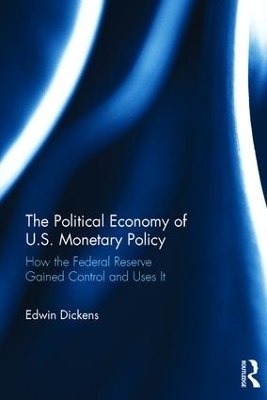
The Political Economy of U.S. Monetary Policy
How the Federal Reserve Gained Control and Uses It
Seiten
2016
Routledge (Verlag)
978-1-138-90931-1 (ISBN)
Routledge (Verlag)
978-1-138-90931-1 (ISBN)
Mainstream economists explain the Federal Reserve’s behavior over its one hundred years of existence as (usually failed) attempts to stabilize the economy on a non-inflationary growth path. The most important monetary event during those first one hundred years was the replacement of fixed exchange rates, based on a gold-exchange standard, with flexible exchange rates.
In this book, Dickens explains how flexible exchange rates became necessary to accommodate the Federal Reserve’s relentless efforts to prevent progressive social change. It is argued that the Federal Reserve is an institutionalized alliance of the large New York banks and the large regional banks. When these two groups of banks are united, they constitute an unassailable force in the class conflict. However, when the large regional banks are at loggerheads with the large New York banks over the proper role of bank clearinghouses during the populist period, along with the proper role of the Eurodollar market during the social democratic period, there is an opening for progressive social reforms.
This book builds upon Hyman Minsky’s financial instability hypothesis as well as the Marxian model constructed by Thomas Piketty. It follows Piketty’s historical method of deepening our understanding of the current Neoliberal Era (1980-2014) of global financial capitalism by comparing and contrasting it with the first era of global financial capitalism—the Gilded Age (1880-1914). In contrast with Piketty, however, this book incorporates monetary factors, including monetary policy, into the set of determinants of the long-run rate of economic growth. This book is suitable for those who study political economy, banking as well as macroeconomics.
In this book, Dickens explains how flexible exchange rates became necessary to accommodate the Federal Reserve’s relentless efforts to prevent progressive social change. It is argued that the Federal Reserve is an institutionalized alliance of the large New York banks and the large regional banks. When these two groups of banks are united, they constitute an unassailable force in the class conflict. However, when the large regional banks are at loggerheads with the large New York banks over the proper role of bank clearinghouses during the populist period, along with the proper role of the Eurodollar market during the social democratic period, there is an opening for progressive social reforms.
This book builds upon Hyman Minsky’s financial instability hypothesis as well as the Marxian model constructed by Thomas Piketty. It follows Piketty’s historical method of deepening our understanding of the current Neoliberal Era (1980-2014) of global financial capitalism by comparing and contrasting it with the first era of global financial capitalism—the Gilded Age (1880-1914). In contrast with Piketty, however, this book incorporates monetary factors, including monetary policy, into the set of determinants of the long-run rate of economic growth. This book is suitable for those who study political economy, banking as well as macroeconomics.
Edwin Dickens is Professor and Chair at the Department of Economics and Finance at Saint Peter’s University, New Jersey, U.S.
Introduction 1. The Theoretical Framework 2. The Origin of the Federal Reserve System: The Institutionalization of the Alliance Between the Large New York Banks and the Large Regional Banks 3. Democratic Control Versus Banker Control of the Federal Reserve System 4. The Federal Reserve’s Implacable Opposition to Social Democracy 5. The End of the Golden Age of Relatively Stable Capitalist Development 6. The Eurodollar Market and Flexible Exchange Rates: The Linchpins of the Current Neoliberal Era of Global Financial Capitalism 7. Summary and Conclusions
| Erscheinungsdatum | 19.07.2016 |
|---|---|
| Zusatzinfo | 15 Tables, black and white; 2 Line drawings, black and white; 2 Illustrations, black and white |
| Verlagsort | London |
| Sprache | englisch |
| Maße | 156 x 234 mm |
| Gewicht | 520 g |
| Themenwelt | Wirtschaft ► Betriebswirtschaft / Management ► Finanzierung |
| Betriebswirtschaft / Management ► Spezielle Betriebswirtschaftslehre ► Bankbetriebslehre | |
| Wirtschaft ► Volkswirtschaftslehre ► Finanzwissenschaft | |
| Wirtschaft ► Volkswirtschaftslehre ► Makroökonomie | |
| ISBN-10 | 1-138-90931-9 / 1138909319 |
| ISBN-13 | 978-1-138-90931-1 / 9781138909311 |
| Zustand | Neuware |
| Haben Sie eine Frage zum Produkt? |
Mehr entdecken
aus dem Bereich
aus dem Bereich
warum unser Geld stirbt und wie Sie davon profitieren
Buch | Hardcover (2024)
FinanzBuch (Verlag)
30,00 €
denken und handeln wie ein professioneller Trader
Buch | Softcover (2023)
Vahlen, Franz (Verlag)
36,90 €


